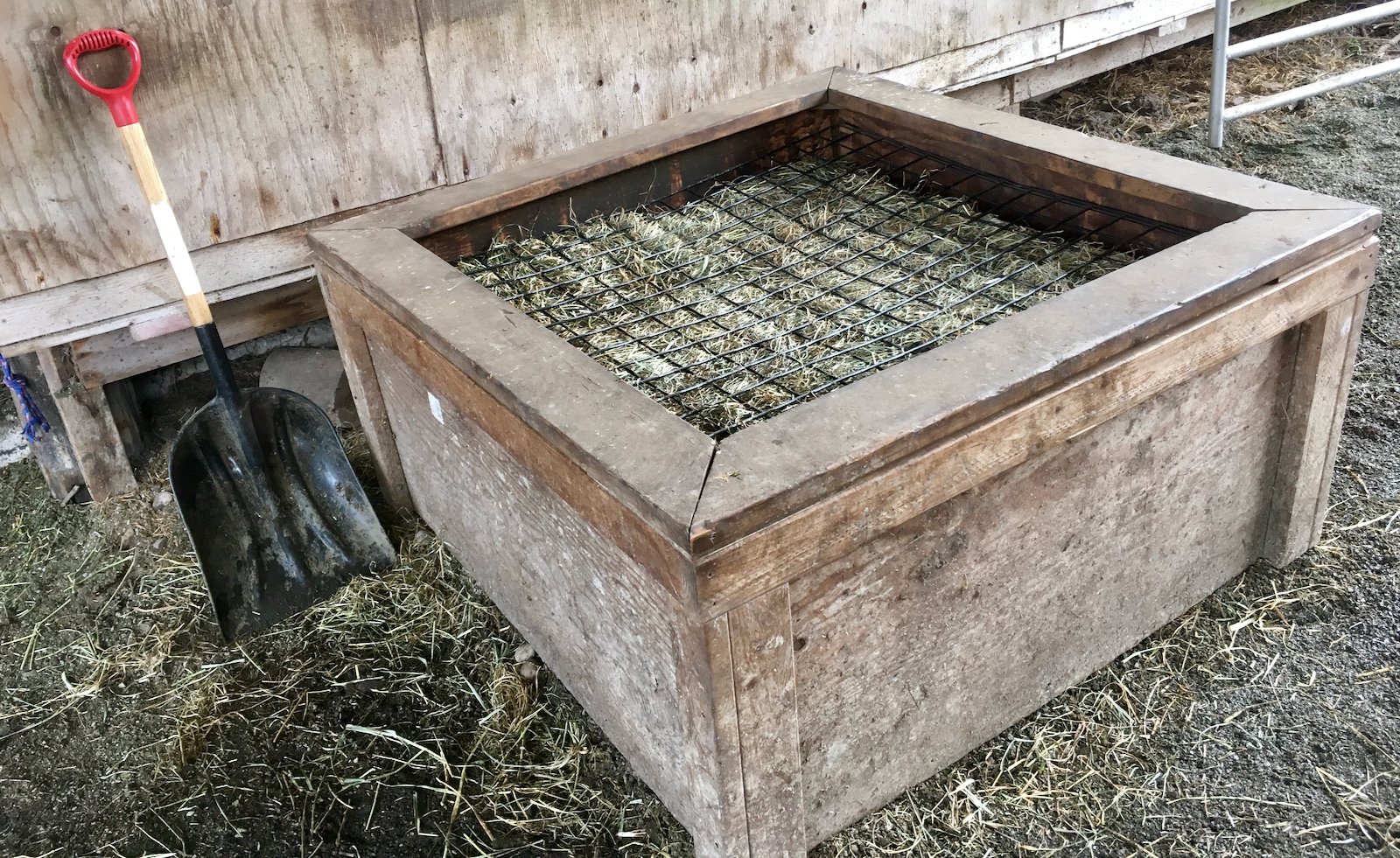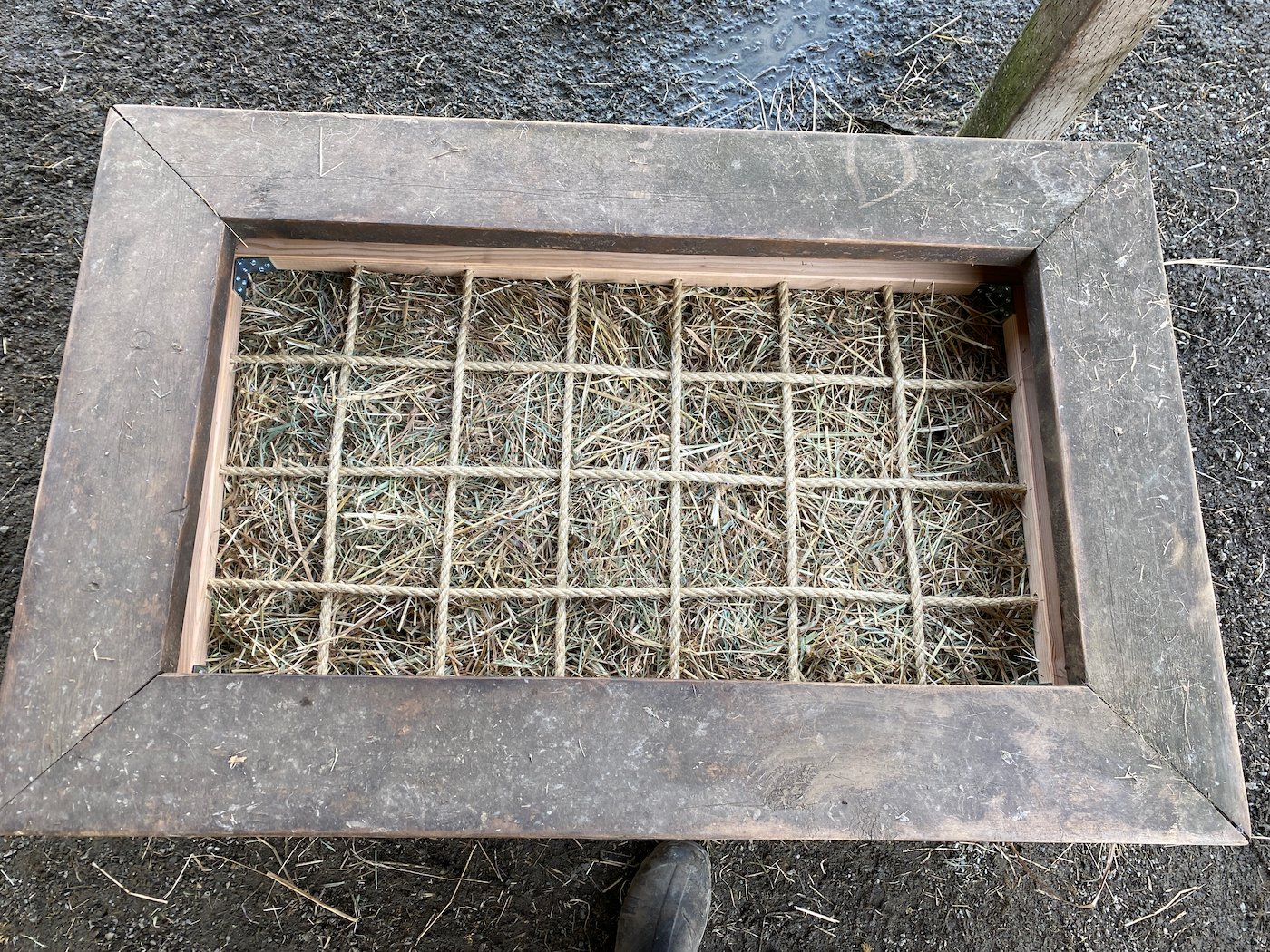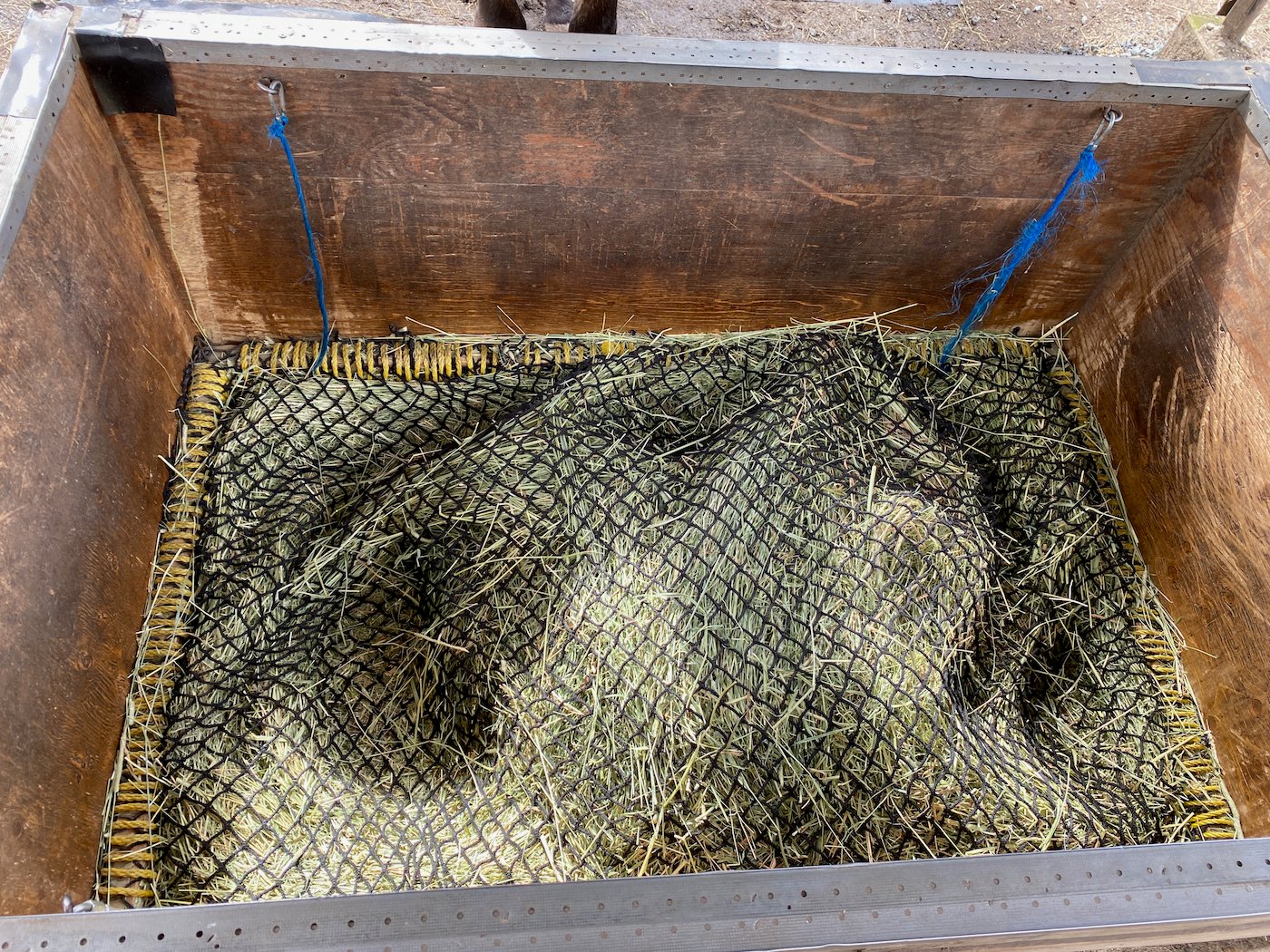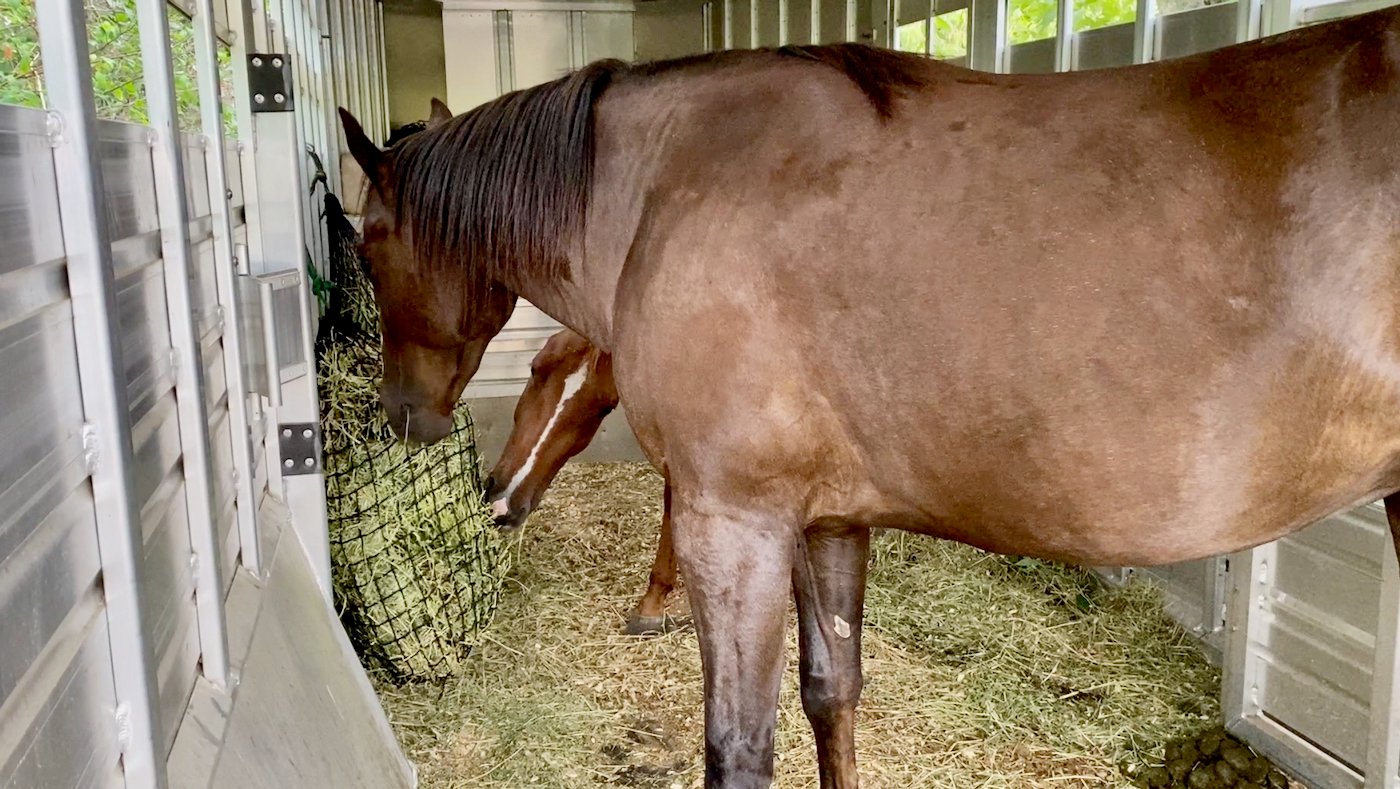You may have already heard how haynets can cause damage to horse’s gums, and metal grates on slow feeders can cause damage to tooth enamel. Well I’m going to share my experiments of using both over the course of 7 years with my herd of 11 horses, varying in age from foal to 16 years. Along with some recent research that’s come out of Europe.
I started off using hay nets combined with slow feeder boxes with 2×2-inch metal grates:

I checked the horses’ teeth regularly and everyone was fine, for about 2 years. Then Montaro came and showed me a chip in one of his teeth and that it was from the metal grate. So I switched out all the grates to a larger 2×4-inch opening:

Nope. That still wasn’t working well and you can see in the photo above how they would get a lot of hay breakage. Whenever the hay is too difficult to extract, that’s your cue that they are having to work hard with their teeth, or they are having to press into the grate or net with their gums to get the hay out.
So then I switched to 4×4-inch metal grates – which still kept hay wastage to a minimum, but from watching and videoing them as they ate, seemed to provide a big enough opening for them to be able to extract the hay without damaging teeth or gums.

The 4×4-inch opening metal grates worked well for the next 4 years. No issues whatsoever. Then all of a sudden, two of the horses developed tooth damage! 8-year-old Audelina showed damage to the enamel on her front incisors. And 2-year-old Posa wore down her two bottom front teeth. So I immediately replaced half of the metal grates with hay nets ranging from 1.5 to 2-inch openings. And on any day that was sunny, we threw 1-2 bales loose into the field for them. After two weeks of monitoring teeth, Xadaa had developed gum damage from the nets!
This spurred me to go on a massive brainstorm to test a variety of different slow feeder grate ideas to see what the horses actually preferred, that didn’t cause any tooth or gum damage, and kept hay wastage to a minimum (which also keeps their gravel footing in good shape; allowing their hooves to stay dry in our rainy climate and helping them self-trim their hooves).
Bob Peters, DVM, of McKinlay and Peters Equine Hospital, in Newman Lake, Washington says he saw a lot of damage to the enamel on upper incisors from metal grates. And if people were using hay nets, then he saw teeth getting hooked on the corded netting – especially with horses under age 5 who sometimes had loose baby teeth pulled out from getting hooked (sometimes with gum laceration). Peters says:
“The safest and least damaging to the teeth are the nets [webbing] that have 1- to 2-inch openings made from 1-inch-wide nylon straps.”
This is what 1-inch wide nylon straps look like when turned into a webbed hay grate:

And if you wanted to create one with straps closer together, you could create a webbed grate with smaller openings. Derby Originals even makes a webbed hay bag that can sit out in your field or paddock:

For my crew, because of my gravel that needs to stay clean and dry through our 7-month rainy season, I wanted to stick with grates that could fit in my slowfeeder boxes, rather than loose hay bags, or hanging hay nets. I couldn’t find any webbed solution that would work for my boxes – they were all the wrong size and I couldn’t find a custom-made version. So here are the experiments I carried out – to see which design the horses preferred, that also minimized hay wastage, and did not cause any damage to teeth or gums:
Sisal Slow Feeder Grate
This grate is strung with 3/4″ diameter natural Sisal rope, with 5-inch openings. However, because this is hand-strung and the rope stretches with use, the horse can easily push the ropes to create 6-inch or larger openings. There is no way this grate will create any pressure on teeth or gums:

This solution is not bad… it certainly creates zero pressure or damage to gums or teeth. The horses seem to like it – but not as much as the 2.75″ hay net grate. But due to the large openings, we do get more hay wastage from this feeder. The sisal rope has held up well though, as has the wooden frame, but it is way more work to build than the hay net grate, since you have to drill so many holes. If I wanted to go with this design again, I would make the openings only 3 inches, which would stretch to 4 inches when pressure is applied.
Wooden Slat Slow Feeder Grate
I’d never seen this done, so figured I might as well try it. Wooden slats/bars will certainly be more sturdy than rope or material the horses can chew through, bend or otherwise damage. I also measured the width of Audelina’s muzzle (my Belgian mare and biggest horse) and it was just under 5 inches wide. So this way, the horses will be able to fit their entire muzzle between the slats, thereby causing zero stress to their teeth or gums:

This solution was a total fail. The wooden slats loosened within a month from the wear-and-tear. And the horses created the most hay wastage around this feeder than any other. A waste of time, wood and hay.
Hay Net Slow Feeder Grate
For this next slowfeeder grate, I tried to find a hay net with 3 or 4-inch openings, but 2.75-inch was the largest I could find from Nag Bags. I really wanted to be able to order 3-inch from Orange Slow Feeder since they have the only haynet material big mama Audelina has not chewed through, but they only offer 1.75″ openings.
I’m thinking perhaps it’s not so much about finding the perfect slowfeeding solution, because all horses are different. But perhaps if horses like Xadaa have various options to choose from, they won’t use a hay net that would damage their gums:

Turns out most of the horses love the 2.75″ hay net! It was the perfect balance between hugely reducing hay wastage and not causing any damage to their gums (see the video above). The only issue I had was with the 4×4-foot wooden frame. For a frame this big, even reinforcing with brackets didn’t make it sturdy enough, nor did gluing the screws. So either the wood needs to be bigger/thicker, or a steel frame would be ideal. I think having a very sturdy steel gauge frame custom-welded would be a good idea for long-term usage. I’m hoping to move all the horses to the Singing Horse Ranch in the Spring, so I’m hoping my wood frames can hold out until then.
We used hay bale twine to wrap and secure the net around the wooden frame – a great way to re-use this material if you’re not yet recycling your hay bale twine. My slowfeeder boxes all have lids, so I don’t need to worry about these grates getting tossed out of the feeder. But if you didn’t have lids, and just had an open box, I saw this example at a horse boarding facility for an easy way to secure your haynet grate, using hay bale twine passed through the grate and clipped at both ends. You can see they are also a lot more rigorous than me in wrapping/attaching their hay net to the frame!:

Now let’s talk about another important issue when making sure your slow feeding solution is not damaging your horse…
Horse Feeding Position
In my article comparing various slowfeeder designs, I had discussed the potential damage caused by slow feeders that cause horses’ heads and necks to be held at unnatural angles or heights for prolonged periods of time. Well turns out my commonsense observation has some scientific backing. Martine Hausberger, PhD, director of the Laboratory of Animal and Human Ethology, University of Rennes says this creates significant issues for their physical health and welfare:
“Anything that puts the horse’s neck in a different position than what it should be in risks consequences for the vertebral column,” she explains. “If they’re spending large amounts of time in inappropriate head and neck positions while eating, this could lead to major back and neck problems. On average, 77% of domestic horses have problems of the vertebral column, and studies show that in natural conditions horses spend 60% of their time eating with the head down. Feeding position is certainly a risk to consider.”
Hausberger also speaks out about the psychological damage done when people make the haynets too difficult for the horse to extract the hay. I’ve read many posts on walking track groups on Facebook where people are taking the smallest-opening hay nets they can find, and then double-layering them! Sometimes I’ve even seen people triple-layer (3 haynets!) their horses hay nets in order to “slow the horse down”. Imagine if someone did this to your food: Here you are, eat your meal with your hands tied and a fine mesh screen on top of your food, enjoy! NOT.
This same frustration can be caused by hay nets that swing around, making it very difficult for the horse to extract a mouthful. So make sure your hay nets are up against a wall, post, or fence. I also anchor my hay nets at both ends.
If you’re using tiny, or multiple-layer hay nets as a weight reduction strategy, you’re actually working against your horse’s physiology and psychology. Dr. Juliet Getty has written about the fact that horse metabolism works the same way as human metabolism; if we think we’re starving, or food is scarce, we will lower our metabolism to retain/gain weight, as a protection against famine and malnutrition. If you set it up so that your horse is psychologically deprived or frustrated with food, never experiences satiety, or is worried about getting enough food (because you’ve made it difficult or scarce), then you are encouraging your horse to gain and retain excess weight.
For everyone who’s said, “I’ve tried slow feeding and it didn’t work!” The next question is: But did you feed ONLY low sugar hay? This is the game-changer! And yes, I’ve tested this on my herd of drafts and half-drafts, Arab, Fjord, Andalusian, Mustang etc. If I give them ‘normal’ hay, they will eat much more than they normally do, and within 3-4 weeks I will see noticeable weight gain from over-eating. As soon as I switch back to low sugar hay (12% NSC or lower), their consumption drops and within a month or two the extra weight drops off. I also feed alfalfa (a low sugar legume) as a supplement to make up for the missing amino acids in hay and grass.
Again, like us, horses need to consume the FULL profile of amino acids in order to utilize protein properly. If your horse has a dropped topline, or poor hooves, mane, tail, be sure and investigate chronic protein deficiency. Or here’s the easy button: feed this supplement, along with flaxseed or alfalfa, and all nutrient deficiencies will automatically be addressed.
Lastly, along with making sure their hay is low sugar, I also feed 1st cut hay; which is usually coarser (higher silica content) than other cuts. This helps the horse naturally wear away their teeth, which means less dental work is required! When Zorra (my purebred Andalusian) came to me, her previous owner warned me that she needed to have her teeth filed/floated regularly as this was an issue for her. It’s been 7 years and Zorra hasn’t needed her teeth floated yet!
We can save ourselves so much money, frustration, and reduce the pain to our horses, simply by setting things up for natural, maximum health in their daily life. Remember, most of the work is in the set up. Ongoing systems don’t take much time or energy. And if you think there’s an emotional or energetic component to your horse’s obesity, then check out this article.

Jini Patel Thompson is a natural health writer and Lazer Tapping instructor. She began riding at age 2 in Kenya, and got her first horse at age 8 in Alberta, and so continues a life-long journey and love affair with these amazing creatures.










Thankyou for sharing this research! Excellent!
I had an idea about the slow feeders.
What about digging them down into the earth so the horse feeds in a more natural position closer to the ground.
It would depend on drainage in the feeding area of course.
Just a thought.
Much love
Erin💚🐎🌳
Exactly – drainage would be key. But if you were in a bone dry area and only filled a day’s worth of hay at a time, why not? ALTHOUGH, you don’t want to have the actual hay/net below ground or the horse won’t be able to reach it 😉
This is a fabulous article. I had no idea and we were going to use haynets. I will not now and I’m just wondering how your horse that had the chipped tooth is doing? I dint know how I found your page but I’m so glad I did thank you.
Her tooth is fine. And haynets worked fine for her and the others – as long as the openings were 2″. The KEY is really low sugar, 1st-cut hay (coarser and more silica so enable them to maintain their teeth). Then they won’t overeat with the larger openings.
Thanks for this great info, Jini. I always appreciate your combination of personal experience, trial and error and research! I’ve had a sense that my slow feeder nets were causing gum issues and I also noticed that they seem to wear down their whiskers. Have you ever seen this?
No I haven’t Tina – but then most of the hay nets I use are 1.5″ – 2.5″. I’ve seen many people use 1/2″ nets or even double and triple layer them! I could see the whiskers getting damaged in those scenarios. Of course, the solution is not to make the hay insanely hard to get at, the solution is to find a LOW SUGAR (coarse 1st cut is good and less tasty so they only eat what they need) hay supplier. 🙂
I have two mustang burros and a rescued elderly Polish Arabian who came to me with bad teeth issues and cannot chew well enough for nutrition. He gets supplemented with special feed. The problem is, the burros eat nicely but my Arabian likes to toss all the hay out of the bins in the pastures. It then gets tromped on, pooped and peed on and becomes inedible for them. He wastes a lot of hay. He chews through hay nets and after reading about the tooth damage possibilities, I am glad I don’t use them anymore. I am still trying to find something that won’t break my bank account that I can feed square bales and “Pickles” won’t be able to waste most of the hay. Hay is too expensive to waste like he does. All of my babies are outside 24/7 with shelters. I would cherish suggestions!!
Hi Terressa, what about a plastic barrel with holes cut it in it? OR you could do a grate over a feeder box like the one in the video, with round holes cut into a board.
Have you also tried one of those hanging horse balls that he can toss around? Since he obviously likes to play, perhaps if you get him a few toys he will enjoy them more than tossing hay… here’s some ideas:
https://www.amazon.com/Horsemens-Pride-Jolly-Stall-Horses/dp/B09VLTHQZN
https://www.amazon.com/PATIKIL-Feeders-Feeding-Relieve-Hanging/dp/B0BJ736ZS5
https://www.amazon.com/Horsemens-Pride-14-Inch-Horse-Jolly/dp/B00B24JRZC
Let us know what happens!
Terressa answered:
“First, he is not a very playful boy. He is estimated to be 24. He seems to toss the hay to get at the fine pieces that fall to the bottom. He is fed outside with two mustang burros. I like the ball idea but he has never been interested in toys of any kind. I was looking at doing a grate on top of the bins until I read about the tooth damage, he doesn’t have good teeth now. The barrel is an idea I like but with three together, will it get pushed over? I like the barrel – it would keep it dry but would it keep him from just pulling out hay until he finds what he likes? I really do appreciate that you took the time to share these ideas. Thank you.😊 ”
So my REPLY to that is:
Ah gotcha! I once tried layering alfalfa under the regular hay in the slow feeder boxes and exactly the same thing happened. They pulled out the regular hay and dropped most of it (didn’t eat it) so they could get to the good stuff underneath. Understandable. And I didn’t do that again – I gave them their alfalfa loose in another location, and they never messed with the slow feeders again.
So no idea what you could do… other than switching to a hay supplier with a more uniform product?? So there are no “good bits” worth hunting for. Let us know if you ever figure it out!
I live with a domestic herd that have very mixed and often conflicting needs in terms of feed – from a large Percheron who struggles to keep weight on to his best buddy a mini donkey who could live on foraging sparse herbs and the tough hay bits to an old quarter horse with TMJ issues that are deeply aggravated by hay nets to a young horse prime for metabolic issues.. I’ve come up with a system where I have 4 hay boxes spread around that the minis can’t get into, 3 hay nets in my big shelter. I divide their total daily hay into 2 and feed morning and night. About 15% goes into the nets, 30% into the various boxes and the rest gets spread about in very small piles. This keeps everyone walking and no competition for food. They can naturally eat with whoever they want, when they want. I feed about 8am and 8pm, by about 4pm they are essentially done with the piles and boxes and spend a few hours picking up all the little bits around or using the hay nets. There is very little waste and although I know this wouldn’t work for everyone’s set up and schedule, it seems to be a formula that serves the easy and hard keepers, big and small ones. I share this as encouragement to think outside the box and let your imagination go. Very often there is a creative solution (that doesn’t break the bank), we just get so tired (because horse work is demanding work) and fixed on the options we have. You clearly care a lot – because you’re here! Good luck ❤️
I’m interested in the hay boxes your minis can’t get to Tina… is it because they’re set too high? Or?
Hi Jini – yes, the height of the boxes and the fact that I only fill them half way means the mini’s can’t get at the hay. They are 34″ and 36″ tall and the feeders are set 4″ off the ground with 36″ sides. Of course they like to stand with the big horses while they eat out of them and catch the bits they drop 🙂
Oh bless! Well I think you’ve come up with wonderful solutions for a difficult feeding situation. Well done 🙂